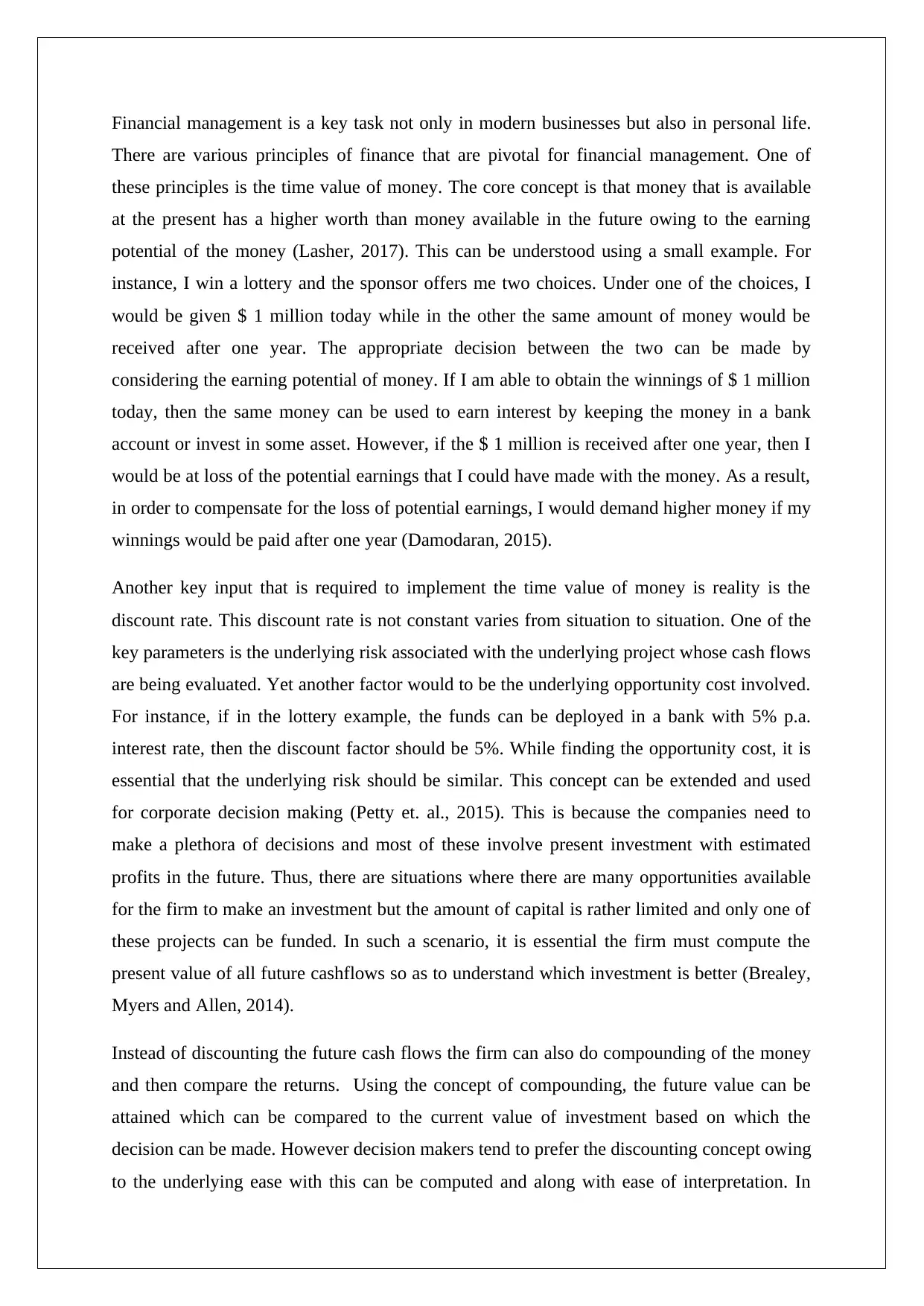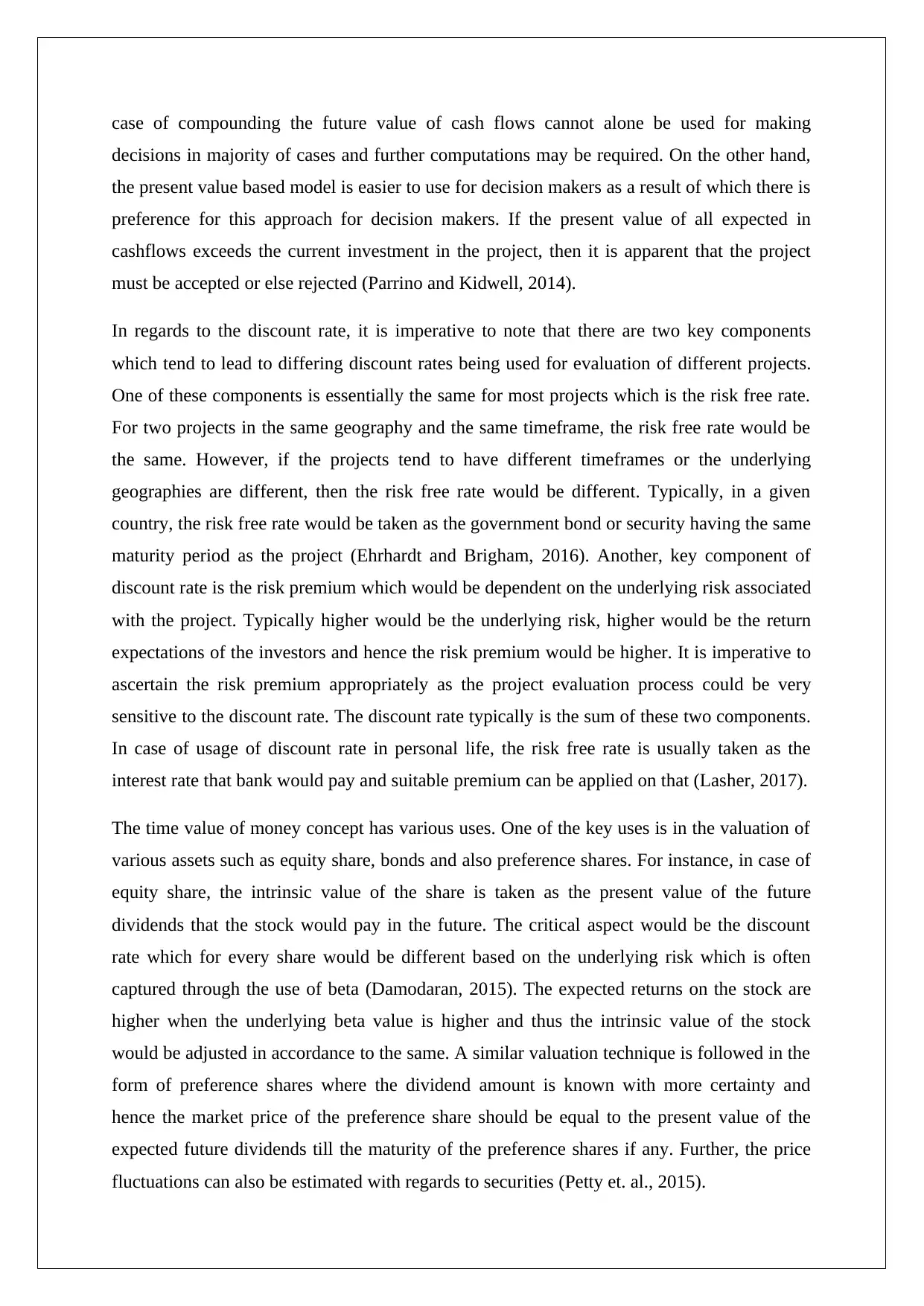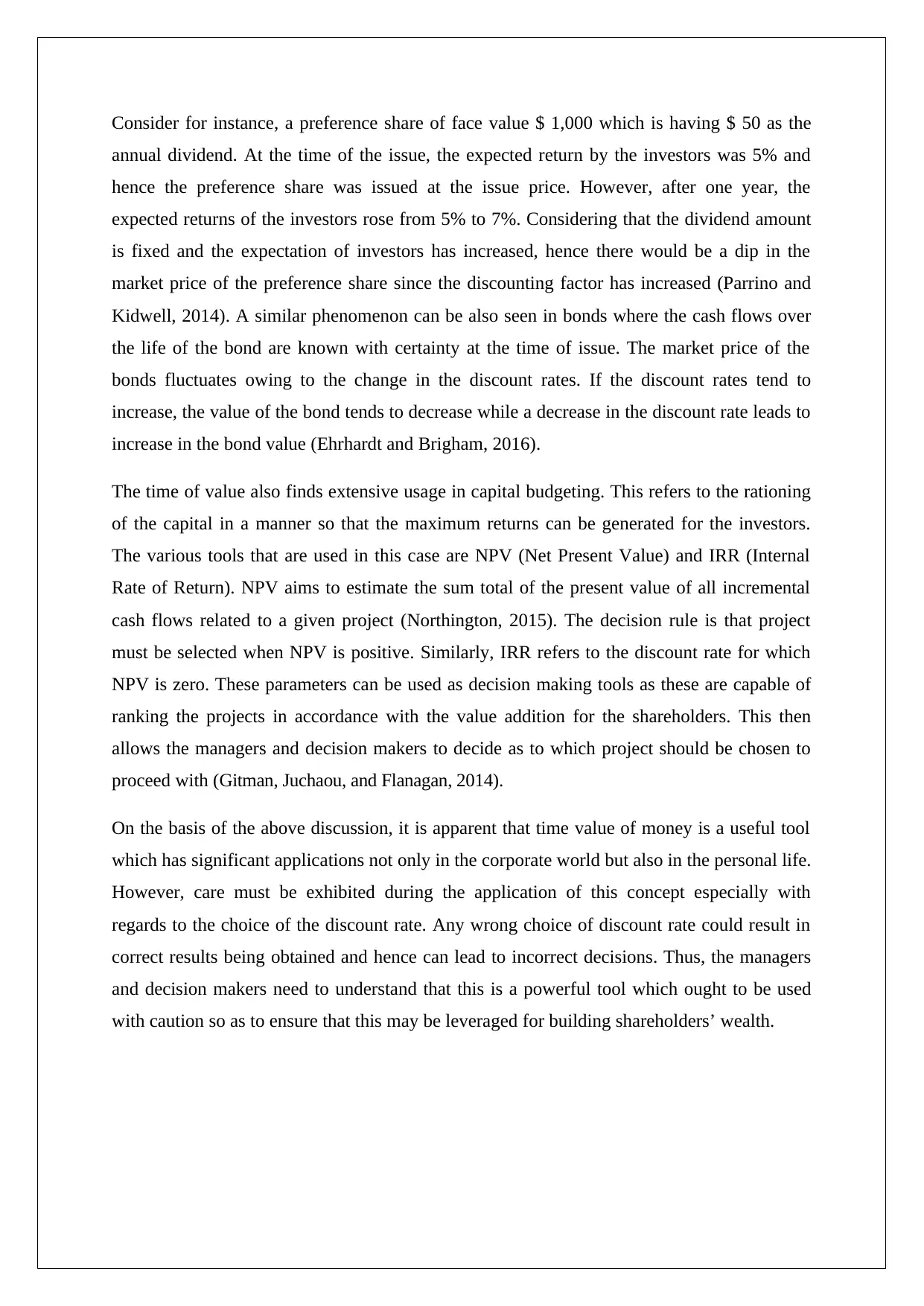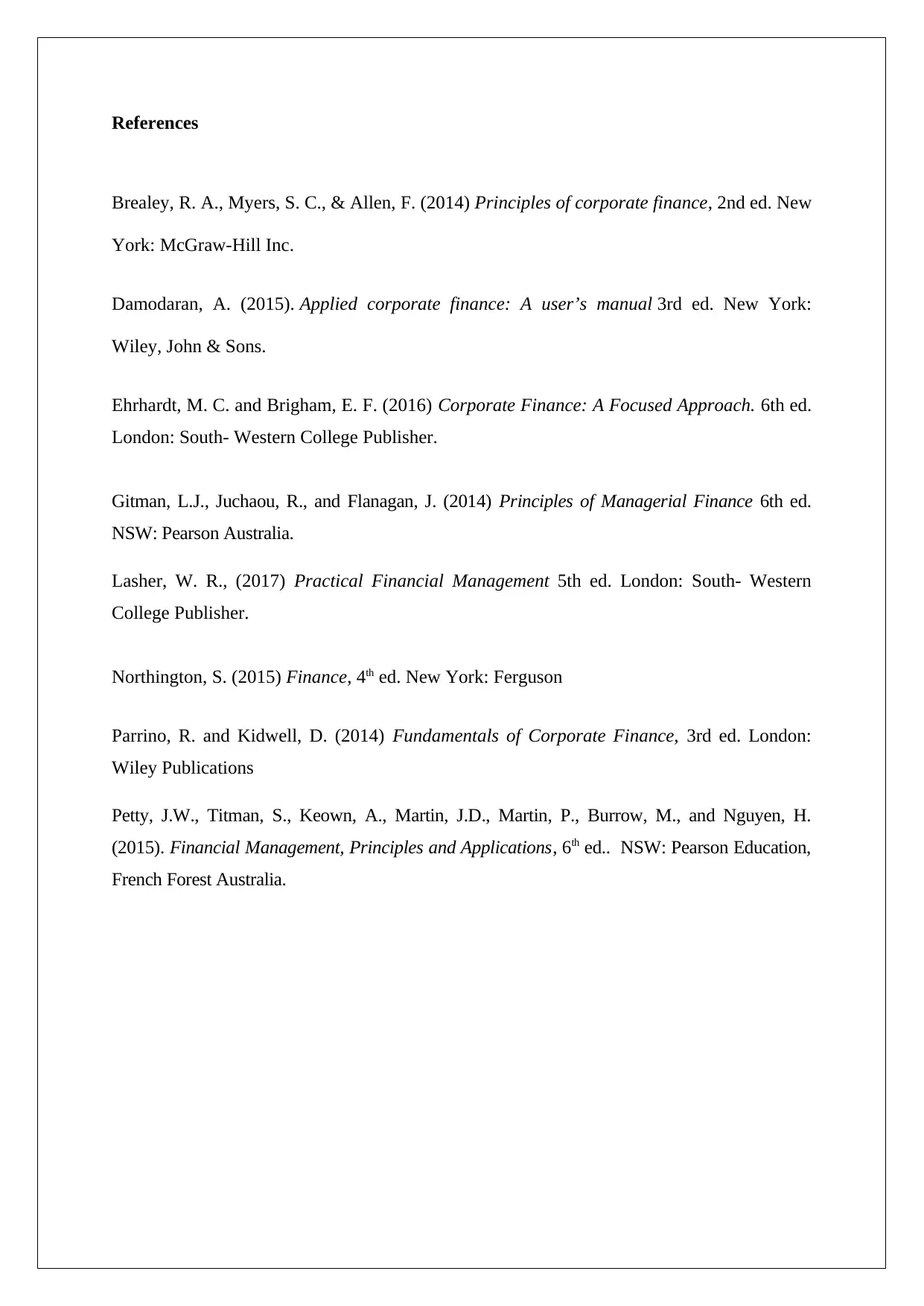The Significance of Time Value of Money in Business Finance
VerifiedAdded on 2023/06/11
|5
|1857
|412
Essay
AI Summary
This essay discusses the principle of the time value of money and its applications in business finance. It explains that money available today is worth more than the same amount in the future due to its earning potential. The essay highlights the importance of the discount rate, influenced by risk and opportunity cost, in evaluating investment projects. It covers how companies use present value calculations to make investment decisions, comparing it with the compounding method. The essay also details the two components of the discount rate: the risk-free rate and the risk premium. Furthermore, it explores the use of the time value of money in asset valuation, capital budgeting, and tools like Net Present Value (NPV) and Internal Rate of Return (IRR). The essay concludes by emphasizing the need for caution in selecting the appropriate discount rate to ensure accurate financial decisions. Desklib provides access to more solved assignments and resources for students.

BUSINESS FINANCE
STUDENT ID
[Pick the date]
STUDENT ID
[Pick the date]
Paraphrase This Document
Need a fresh take? Get an instant paraphrase of this document with our AI Paraphraser

Financial management is a key task not only in modern businesses but also in personal life.
There are various principles of finance that are pivotal for financial management. One of
these principles is the time value of money. The core concept is that money that is available
at the present has a higher worth than money available in the future owing to the earning
potential of the money (Lasher, 2017). This can be understood using a small example. For
instance, I win a lottery and the sponsor offers me two choices. Under one of the choices, I
would be given $ 1 million today while in the other the same amount of money would be
received after one year. The appropriate decision between the two can be made by
considering the earning potential of money. If I am able to obtain the winnings of $ 1 million
today, then the same money can be used to earn interest by keeping the money in a bank
account or invest in some asset. However, if the $ 1 million is received after one year, then I
would be at loss of the potential earnings that I could have made with the money. As a result,
in order to compensate for the loss of potential earnings, I would demand higher money if my
winnings would be paid after one year (Damodaran, 2015).
Another key input that is required to implement the time value of money is reality is the
discount rate. This discount rate is not constant varies from situation to situation. One of the
key parameters is the underlying risk associated with the underlying project whose cash flows
are being evaluated. Yet another factor would to be the underlying opportunity cost involved.
For instance, if in the lottery example, the funds can be deployed in a bank with 5% p.a.
interest rate, then the discount factor should be 5%. While finding the opportunity cost, it is
essential that the underlying risk should be similar. This concept can be extended and used
for corporate decision making (Petty et. al., 2015). This is because the companies need to
make a plethora of decisions and most of these involve present investment with estimated
profits in the future. Thus, there are situations where there are many opportunities available
for the firm to make an investment but the amount of capital is rather limited and only one of
these projects can be funded. In such a scenario, it is essential the firm must compute the
present value of all future cashflows so as to understand which investment is better (Brealey,
Myers and Allen, 2014).
Instead of discounting the future cash flows the firm can also do compounding of the money
and then compare the returns. Using the concept of compounding, the future value can be
attained which can be compared to the current value of investment based on which the
decision can be made. However decision makers tend to prefer the discounting concept owing
to the underlying ease with this can be computed and along with ease of interpretation. In
There are various principles of finance that are pivotal for financial management. One of
these principles is the time value of money. The core concept is that money that is available
at the present has a higher worth than money available in the future owing to the earning
potential of the money (Lasher, 2017). This can be understood using a small example. For
instance, I win a lottery and the sponsor offers me two choices. Under one of the choices, I
would be given $ 1 million today while in the other the same amount of money would be
received after one year. The appropriate decision between the two can be made by
considering the earning potential of money. If I am able to obtain the winnings of $ 1 million
today, then the same money can be used to earn interest by keeping the money in a bank
account or invest in some asset. However, if the $ 1 million is received after one year, then I
would be at loss of the potential earnings that I could have made with the money. As a result,
in order to compensate for the loss of potential earnings, I would demand higher money if my
winnings would be paid after one year (Damodaran, 2015).
Another key input that is required to implement the time value of money is reality is the
discount rate. This discount rate is not constant varies from situation to situation. One of the
key parameters is the underlying risk associated with the underlying project whose cash flows
are being evaluated. Yet another factor would to be the underlying opportunity cost involved.
For instance, if in the lottery example, the funds can be deployed in a bank with 5% p.a.
interest rate, then the discount factor should be 5%. While finding the opportunity cost, it is
essential that the underlying risk should be similar. This concept can be extended and used
for corporate decision making (Petty et. al., 2015). This is because the companies need to
make a plethora of decisions and most of these involve present investment with estimated
profits in the future. Thus, there are situations where there are many opportunities available
for the firm to make an investment but the amount of capital is rather limited and only one of
these projects can be funded. In such a scenario, it is essential the firm must compute the
present value of all future cashflows so as to understand which investment is better (Brealey,
Myers and Allen, 2014).
Instead of discounting the future cash flows the firm can also do compounding of the money
and then compare the returns. Using the concept of compounding, the future value can be
attained which can be compared to the current value of investment based on which the
decision can be made. However decision makers tend to prefer the discounting concept owing
to the underlying ease with this can be computed and along with ease of interpretation. In

case of compounding the future value of cash flows cannot alone be used for making
decisions in majority of cases and further computations may be required. On the other hand,
the present value based model is easier to use for decision makers as a result of which there is
preference for this approach for decision makers. If the present value of all expected in
cashflows exceeds the current investment in the project, then it is apparent that the project
must be accepted or else rejected (Parrino and Kidwell, 2014).
In regards to the discount rate, it is imperative to note that there are two key components
which tend to lead to differing discount rates being used for evaluation of different projects.
One of these components is essentially the same for most projects which is the risk free rate.
For two projects in the same geography and the same timeframe, the risk free rate would be
the same. However, if the projects tend to have different timeframes or the underlying
geographies are different, then the risk free rate would be different. Typically, in a given
country, the risk free rate would be taken as the government bond or security having the same
maturity period as the project (Ehrhardt and Brigham, 2016). Another, key component of
discount rate is the risk premium which would be dependent on the underlying risk associated
with the project. Typically higher would be the underlying risk, higher would be the return
expectations of the investors and hence the risk premium would be higher. It is imperative to
ascertain the risk premium appropriately as the project evaluation process could be very
sensitive to the discount rate. The discount rate typically is the sum of these two components.
In case of usage of discount rate in personal life, the risk free rate is usually taken as the
interest rate that bank would pay and suitable premium can be applied on that (Lasher, 2017).
The time value of money concept has various uses. One of the key uses is in the valuation of
various assets such as equity share, bonds and also preference shares. For instance, in case of
equity share, the intrinsic value of the share is taken as the present value of the future
dividends that the stock would pay in the future. The critical aspect would be the discount
rate which for every share would be different based on the underlying risk which is often
captured through the use of beta (Damodaran, 2015). The expected returns on the stock are
higher when the underlying beta value is higher and thus the intrinsic value of the stock
would be adjusted in accordance to the same. A similar valuation technique is followed in the
form of preference shares where the dividend amount is known with more certainty and
hence the market price of the preference share should be equal to the present value of the
expected future dividends till the maturity of the preference shares if any. Further, the price
fluctuations can also be estimated with regards to securities (Petty et. al., 2015).
decisions in majority of cases and further computations may be required. On the other hand,
the present value based model is easier to use for decision makers as a result of which there is
preference for this approach for decision makers. If the present value of all expected in
cashflows exceeds the current investment in the project, then it is apparent that the project
must be accepted or else rejected (Parrino and Kidwell, 2014).
In regards to the discount rate, it is imperative to note that there are two key components
which tend to lead to differing discount rates being used for evaluation of different projects.
One of these components is essentially the same for most projects which is the risk free rate.
For two projects in the same geography and the same timeframe, the risk free rate would be
the same. However, if the projects tend to have different timeframes or the underlying
geographies are different, then the risk free rate would be different. Typically, in a given
country, the risk free rate would be taken as the government bond or security having the same
maturity period as the project (Ehrhardt and Brigham, 2016). Another, key component of
discount rate is the risk premium which would be dependent on the underlying risk associated
with the project. Typically higher would be the underlying risk, higher would be the return
expectations of the investors and hence the risk premium would be higher. It is imperative to
ascertain the risk premium appropriately as the project evaluation process could be very
sensitive to the discount rate. The discount rate typically is the sum of these two components.
In case of usage of discount rate in personal life, the risk free rate is usually taken as the
interest rate that bank would pay and suitable premium can be applied on that (Lasher, 2017).
The time value of money concept has various uses. One of the key uses is in the valuation of
various assets such as equity share, bonds and also preference shares. For instance, in case of
equity share, the intrinsic value of the share is taken as the present value of the future
dividends that the stock would pay in the future. The critical aspect would be the discount
rate which for every share would be different based on the underlying risk which is often
captured through the use of beta (Damodaran, 2015). The expected returns on the stock are
higher when the underlying beta value is higher and thus the intrinsic value of the stock
would be adjusted in accordance to the same. A similar valuation technique is followed in the
form of preference shares where the dividend amount is known with more certainty and
hence the market price of the preference share should be equal to the present value of the
expected future dividends till the maturity of the preference shares if any. Further, the price
fluctuations can also be estimated with regards to securities (Petty et. al., 2015).
⊘ This is a preview!⊘
Do you want full access?
Subscribe today to unlock all pages.

Trusted by 1+ million students worldwide

Consider for instance, a preference share of face value $ 1,000 which is having $ 50 as the
annual dividend. At the time of the issue, the expected return by the investors was 5% and
hence the preference share was issued at the issue price. However, after one year, the
expected returns of the investors rose from 5% to 7%. Considering that the dividend amount
is fixed and the expectation of investors has increased, hence there would be a dip in the
market price of the preference share since the discounting factor has increased (Parrino and
Kidwell, 2014). A similar phenomenon can be also seen in bonds where the cash flows over
the life of the bond are known with certainty at the time of issue. The market price of the
bonds fluctuates owing to the change in the discount rates. If the discount rates tend to
increase, the value of the bond tends to decrease while a decrease in the discount rate leads to
increase in the bond value (Ehrhardt and Brigham, 2016).
The time of value also finds extensive usage in capital budgeting. This refers to the rationing
of the capital in a manner so that the maximum returns can be generated for the investors.
The various tools that are used in this case are NPV (Net Present Value) and IRR (Internal
Rate of Return). NPV aims to estimate the sum total of the present value of all incremental
cash flows related to a given project (Northington, 2015). The decision rule is that project
must be selected when NPV is positive. Similarly, IRR refers to the discount rate for which
NPV is zero. These parameters can be used as decision making tools as these are capable of
ranking the projects in accordance with the value addition for the shareholders. This then
allows the managers and decision makers to decide as to which project should be chosen to
proceed with (Gitman, Juchaou, and Flanagan, 2014).
On the basis of the above discussion, it is apparent that time value of money is a useful tool
which has significant applications not only in the corporate world but also in the personal life.
However, care must be exhibited during the application of this concept especially with
regards to the choice of the discount rate. Any wrong choice of discount rate could result in
correct results being obtained and hence can lead to incorrect decisions. Thus, the managers
and decision makers need to understand that this is a powerful tool which ought to be used
with caution so as to ensure that this may be leveraged for building shareholders’ wealth.
annual dividend. At the time of the issue, the expected return by the investors was 5% and
hence the preference share was issued at the issue price. However, after one year, the
expected returns of the investors rose from 5% to 7%. Considering that the dividend amount
is fixed and the expectation of investors has increased, hence there would be a dip in the
market price of the preference share since the discounting factor has increased (Parrino and
Kidwell, 2014). A similar phenomenon can be also seen in bonds where the cash flows over
the life of the bond are known with certainty at the time of issue. The market price of the
bonds fluctuates owing to the change in the discount rates. If the discount rates tend to
increase, the value of the bond tends to decrease while a decrease in the discount rate leads to
increase in the bond value (Ehrhardt and Brigham, 2016).
The time of value also finds extensive usage in capital budgeting. This refers to the rationing
of the capital in a manner so that the maximum returns can be generated for the investors.
The various tools that are used in this case are NPV (Net Present Value) and IRR (Internal
Rate of Return). NPV aims to estimate the sum total of the present value of all incremental
cash flows related to a given project (Northington, 2015). The decision rule is that project
must be selected when NPV is positive. Similarly, IRR refers to the discount rate for which
NPV is zero. These parameters can be used as decision making tools as these are capable of
ranking the projects in accordance with the value addition for the shareholders. This then
allows the managers and decision makers to decide as to which project should be chosen to
proceed with (Gitman, Juchaou, and Flanagan, 2014).
On the basis of the above discussion, it is apparent that time value of money is a useful tool
which has significant applications not only in the corporate world but also in the personal life.
However, care must be exhibited during the application of this concept especially with
regards to the choice of the discount rate. Any wrong choice of discount rate could result in
correct results being obtained and hence can lead to incorrect decisions. Thus, the managers
and decision makers need to understand that this is a powerful tool which ought to be used
with caution so as to ensure that this may be leveraged for building shareholders’ wealth.
Paraphrase This Document
Need a fresh take? Get an instant paraphrase of this document with our AI Paraphraser

References
Brealey, R. A., Myers, S. C., & Allen, F. (2014) Principles of corporate finance, 2nd ed. New
York: McGraw-Hill Inc.
Damodaran, A. (2015). Applied corporate finance: A user’s manual 3rd ed. New York:
Wiley, John & Sons.
Ehrhardt, M. C. and Brigham, E. F. (2016) Corporate Finance: A Focused Approach. 6th ed.
London: South- Western College Publisher.
Gitman, L.J., Juchaou, R., and Flanagan, J. (2014) Principles of Managerial Finance 6th ed.
NSW: Pearson Australia.
Lasher, W. R., (2017) Practical Financial Management 5th ed. London: South- Western
College Publisher.
Northington, S. (2015) Finance, 4th ed. New York: Ferguson
Parrino, R. and Kidwell, D. (2014) Fundamentals of Corporate Finance, 3rd ed. London:
Wiley Publications
Petty, J.W., Titman, S., Keown, A., Martin, J.D., Martin, P., Burrow, M., and Nguyen, H.
(2015). Financial Management, Principles and Applications, 6th ed.. NSW: Pearson Education,
French Forest Australia.
Brealey, R. A., Myers, S. C., & Allen, F. (2014) Principles of corporate finance, 2nd ed. New
York: McGraw-Hill Inc.
Damodaran, A. (2015). Applied corporate finance: A user’s manual 3rd ed. New York:
Wiley, John & Sons.
Ehrhardt, M. C. and Brigham, E. F. (2016) Corporate Finance: A Focused Approach. 6th ed.
London: South- Western College Publisher.
Gitman, L.J., Juchaou, R., and Flanagan, J. (2014) Principles of Managerial Finance 6th ed.
NSW: Pearson Australia.
Lasher, W. R., (2017) Practical Financial Management 5th ed. London: South- Western
College Publisher.
Northington, S. (2015) Finance, 4th ed. New York: Ferguson
Parrino, R. and Kidwell, D. (2014) Fundamentals of Corporate Finance, 3rd ed. London:
Wiley Publications
Petty, J.W., Titman, S., Keown, A., Martin, J.D., Martin, P., Burrow, M., and Nguyen, H.
(2015). Financial Management, Principles and Applications, 6th ed.. NSW: Pearson Education,
French Forest Australia.
1 out of 5
Related Documents
Your All-in-One AI-Powered Toolkit for Academic Success.
+13062052269
info@desklib.com
Available 24*7 on WhatsApp / Email
![[object Object]](/_next/static/media/star-bottom.7253800d.svg)
Unlock your academic potential
Copyright © 2020–2025 A2Z Services. All Rights Reserved. Developed and managed by ZUCOL.





